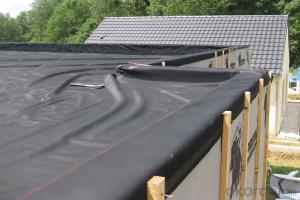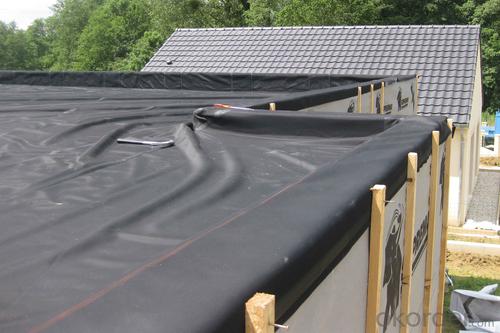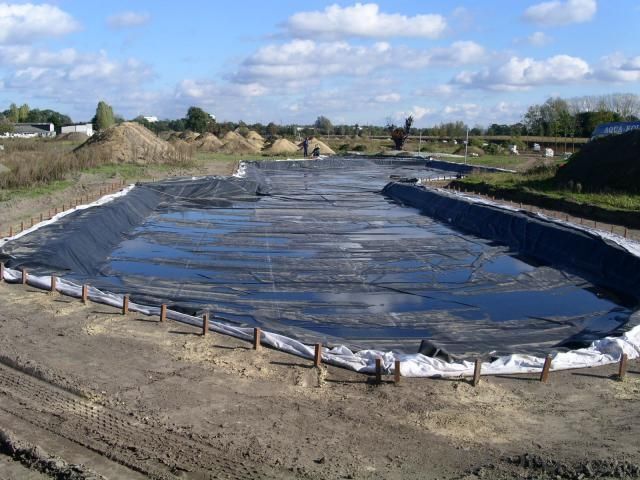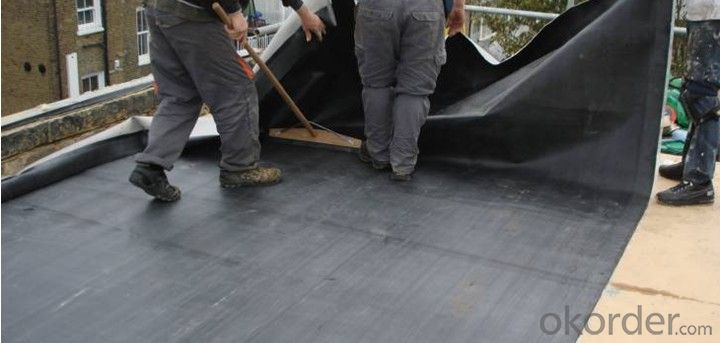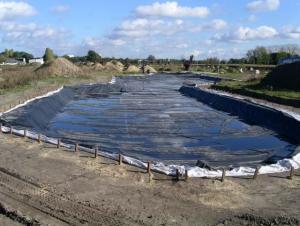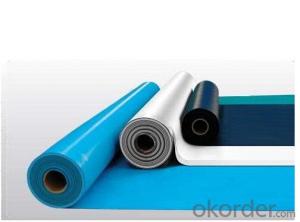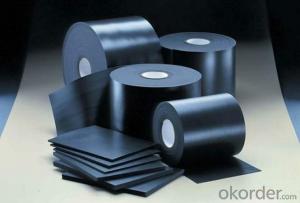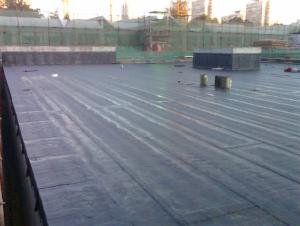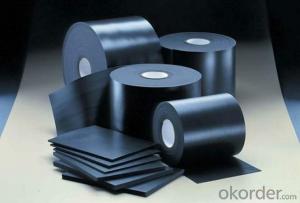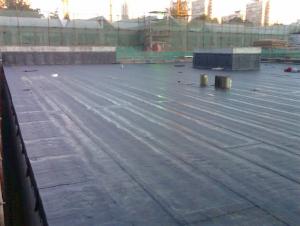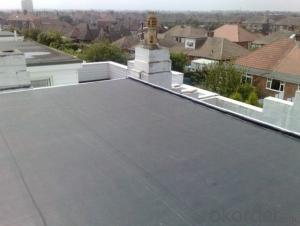EPDM Rubber Coiled Waterproof Membrane for Wooden Roof
- Loading Port:
- Shanghai
- Payment Terms:
- TT OR LC
- Min Order Qty:
- 50000 m²
- Supply Capability:
- 5000000 m²/month
OKorder Service Pledge
OKorder Financial Service
You Might Also Like
EPDM Rubber Coiled Waterproof Membrane for Wooden Roof
Description Of EPDM Rubber Coiled Waterproof Membrane for Wooden Roof:
•EPDM waterproof sheet has excellent anti-ozone-aging performance, able to resist ultraviolet light and corrosion of many chemical corrosive materials in the atmosphere
•It has high tensile strength, high ductility and strong retractility, it has excellent crack resistance, able to effect waterproof function even with tiny vibration of buildings.
• Excellent resistance to ozone, oxidation and sunlight.
• Resistance to chemicals; resistant to most inorganic products.
Main Features of EPDM Rubber Coiled Waterproof Membrane for Wooden Roof:
1>Excellent antiaging performance, service life up to 50 years
2>Working well with in 40C to 100C,it canbe constructed with a single layer in ambient temperature.
3>Waterproofing on various kinds of underground project,industrial of civil buildings and structures.
4>high extension rate, high tensile strength, small size changes at heat treatment
5>Good plant roots penetrability resistance and can be made waterproofing layer of planting roof
6>Special modified molecular structure ,effectively resolving the current domestic and foreign glue joint problem.
7>Good low temperature flexibility, and good performance of adapting to ambient temperature changes.
8>Convenient application ,solid joint, no environment pollution
9>chemical corrosion Resistance, can be used for special occasions
10>Convenient maitenance, low cost.
Specifications of EPDM Rubber Coiled Waterproof Membrane for Wooden Roof:
| Material | EPDM Rubber |
| Size | 1.2m (width)*20m (length) or customized, weldable type 2.05m or 4m width |
| Thick | 1.2mm, 1.5mm, 2.0mm |
| Type | Vulcanized & Weldable |
| Pattern | Non-reinforced (homogeneous) |
| Certificate | ISO9001/14001 |
Applications of EPDM Rubber Coiled Waterproof Membrane for Wooden Roof:
Widely used in roofs, basement, toilet ,swimming pool, and all kinds of industry and civil building waterproofing, reservoir, vivicism, bridge, underground, tunnel and dam waterproofing ,especially to the keystone waterproofing projects which is durability, high corrosion resistance and easy deformation.



IMages of EPDM Rubber Coiled Waterproof Membrane for Wooden Roof:




FAQ of EPDM Rubber Coiled Waterproof Membrane for Wooden Roof:
1. What are we supplying?
We are specialized in producing Colorful Asphalt Roof Shingle, SBS/APP modified bitumen waterproof membrane, Self adhesive bitumen waterproof membrane, PVC waterproofing membrane, EPDM rubber roofing membrane, Single Component Polyurethane Waterproof Coating, and Spray Polyurea Waterproof Coating
.
2. How Many years experience do we have?
We have been exported to more than 20 countries in the past 15 years.
3. How long do we usually reply your request?
We always reply our customer within 24 hours.
- Q: Does a waterproofing membrane require any specific safety precautions during installation?
- Yes, installing a waterproofing membrane does require specific safety precautions. Here are some key precautions to consider: 1. Personal Protective Equipment (PPE): Installers should wear appropriate PPE, including gloves, safety glasses, and protective clothing to prevent skin contact with the membrane and any potential chemical hazards. 2. Adequate Ventilation: Ensure the installation area is well-ventilated to prevent the buildup of fumes or vapors. If working in an enclosed space, use proper ventilation systems to remove any potentially harmful gases or odors. 3. Hazardous Chemicals: Some waterproofing membranes may contain hazardous chemicals or solvents. Installers should carefully read and follow the manufacturer's instructions for handling and using these products. Proper storage, handling, and disposal of chemicals should be observed to avoid accidents or environmental contamination. 4. Slips and Falls: During installation, the surface can become slippery, especially if the membrane is applied on wet surfaces. Installers should take precautions to secure their footing and use appropriate safety equipment like harnesses or guardrails when working at heights to prevent falls. 5. Heat Hazards: Some waterproofing membranes require the use of heat for proper installation. Installers should take precautions when working with heat sources like torches or heat guns to prevent burns or fire hazards. Fire extinguishers should be readily available, and proper training on fire safety protocols is essential. 6. Electrical Safety: Waterproofing membranes may be installed in areas where electrical systems are present. Installers should be cautious when working near live electrical wires or outlets and follow proper electrical safety procedures to prevent electric shocks or fires. It is important for installers to receive proper training and follow all safety guidelines provided by the manufacturer to minimize the risk of accidents, injuries, or property damage during the installation process.
- Q: Are waterproofing membranes effective against mold and mildew?
- Yes, waterproofing membranes are effective against mold and mildew. These membranes provide a barrier that prevents water from infiltrating into the building's structure, thereby reducing the moisture content. Since mold and mildew thrive in damp and humid environments, a waterproofing membrane helps to create a dry and inhospitable environment for their growth. By sealing off the surface, waterproofing membranes prevent water intrusion and the subsequent moisture buildup that promotes mold and mildew formation. Additionally, some waterproofing membranes are specifically designed with anti-microbial properties to further inhibit the growth of mold and mildew. However, it is important to note that while waterproofing membranes can significantly reduce the risk of mold and mildew, proper ventilation and maintenance of the building are also necessary to ensure long-term prevention.
- Q: On the roof of the waterproofing membrane paving the direction of what are the requirements
- ?When the roof slope is greater than 15% (ie, steep sloping roof), taking into account the steep slope, according to the direction of the parallel roof paving sheet operation difficult, while the roof of the heat requirements are higher, easy to flow, and thus vertical roof The coil is more advantageous. As for the polymer modified asphalt waterproofing membrane and synthetic polymer waterproofing membrane, due to good temperature resistance, thinner thickness, there is no flow problem, so the direction of the paving is not limited.
- Q: Can a waterproofing membrane be used for residential buildings or homes?
- Yes, a waterproofing membrane can be used for residential buildings or homes. Waterproofing membranes are commonly used in construction to prevent water penetration and protect the building's structure and interior from moisture damage. They can be applied to various areas such as basements, roofs, foundations, and bathrooms, among others. By creating a barrier against water, these membranes help to prevent leaks, mold growth, and damage to the building materials. Therefore, using a waterproofing membrane is an effective way to ensure the longevity and durability of residential buildings or homes.
- Q: Can a waterproofing membrane be used in conjunction with roofing materials?
- Yes, a waterproofing membrane can be used in conjunction with roofing materials. In fact, it is quite common to use a waterproofing membrane as an added layer of protection for roofs. The membrane is typically applied directly on top of the roofing material, creating an additional barrier against water penetration. This is especially beneficial in areas prone to heavy rainfall or where the roof is exposed to high levels of moisture. The waterproofing membrane helps to prevent leaks, extend the lifespan of the roof, and protect the structure from potential water damage. Additionally, the membrane can also provide added insulation and energy efficiency benefits. Overall, using a waterproofing membrane in conjunction with roofing materials is a wise choice to enhance the waterproofing capabilities and durability of the roof.
- Q: Are there any specific requirements for installing a waterproofing membrane?
- Yes, there are specific requirements for installing a waterproofing membrane. These requirements may vary depending on the type of membrane being used and the specific application. However, some general requirements include: 1. Surface Preparation: The surface where the membrane will be installed must be clean, dry, and free from any dust, debris, or contaminants. Any cracks or defects in the surface should be repaired prior to installation. 2. Adhesive or Bonding Agent: Depending on the type of membrane, an adhesive or bonding agent may be required to ensure proper adhesion to the substrate. This adhesive should be compatible with both the membrane and the substrate. 3. Primer: In some cases, a primer may be necessary to enhance the adhesion between the substrate and the membrane. The type of primer required will depend on the specific membrane and substrate being used. 4. Seam and Joint Preparation: Properly preparing seams and joints is crucial to ensure a watertight installation. This may involve using a specific sealant or tape to reinforce the seams and prevent water penetration. 5. Installation Techniques: The membrane should be installed according to the manufacturer's instructions and industry best practices. This may include using a specific method such as torching, hot air welding, or cold adhesive application. 6. Overlaps and Transitions: Properly overlapping the membrane sheets and ensuring smooth transitions between different areas is essential for a successful installation. This will help prevent water from seeping through gaps or weak points in the membrane. 7. Quality Control: Regular inspections and quality control measures should be implemented throughout the installation process to ensure that the membrane is being installed correctly and meets the required standards. It is important to consult the manufacturer's guidelines and specifications for the specific waterproofing membrane being used, as different membranes may have unique installation requirements. Additionally, local building codes and regulations should also be considered to ensure compliance and to meet any specific requirements in your area.
- Q: Can waterproofing membranes be used on underground tunnels?
- Yes, waterproofing membranes can be used on underground tunnels. Waterproofing membranes are specially designed to provide a barrier against water penetration and are commonly used in various construction applications, including underground structures such as tunnels. These membranes are typically made of materials like bitumen, asphalt, or synthetic rubber, which have excellent waterproofing properties. When applied to the tunnel walls and floors, waterproofing membranes create a protective layer that prevents water from seeping into the tunnel. This is particularly important in underground tunnels as they are susceptible to water intrusion from surrounding soil or groundwater. By using waterproofing membranes, the integrity and durability of the tunnel structure are maintained, reducing the risk of water damage, corrosion, and deterioration. Furthermore, waterproofing membranes can also offer additional benefits such as providing resistance against chemical attacks, preventing the growth of mold and mildew, and improving the overall insulation of the tunnel. These membranes can be applied during the construction phase of the tunnel or as a retrofit solution to existing tunnels. It is important to note that the selection of the appropriate waterproofing membrane should be based on factors such as the type of tunnel, the expected water pressure, and the overall design requirements. Consulting with a professional engineer or waterproofing specialist is highly recommended to ensure the selection and installation of the most suitable waterproofing membrane for underground tunnels.
- Q: Can a waterproofing membrane be used in high-rise buildings?
- Yes, a waterproofing membrane can be used in high-rise buildings. In fact, it is highly recommended to incorporate a waterproofing system in high-rise buildings to protect them from the damaging effects of water infiltration. Waterproofing membranes are designed to provide a barrier against water ingress, preventing leaks and moisture damage to the structure. They are commonly used on roofs, basements, foundations, and other areas that are exposed to water or moisture. The selection of the appropriate waterproofing membrane will depend on various factors such as the specific building design, construction materials, and environmental conditions. It is important to consult with experienced waterproofing professionals to determine the most suitable membrane system for a high-rise building to ensure long-term protection against water-related issues.
- Q: What is the cost of a waterproofing membrane?
- The cost of a waterproofing membrane can vary depending on several factors such as the type of membrane, the size of the area to be covered, and the complexity of the installation. On average, the price ranges from $1 to $4 per square foot for materials only. However, it is important to note that additional costs may be incurred for labor, equipment, and any necessary repairs or preparation work. Therefore, it is recommended to obtain quotes from reputable contractors or suppliers to get an accurate estimate for your specific project.
- Q: How does a waterproofing membrane handle expansion and contraction of a surface?
- A waterproofing membrane is specifically designed to accommodate the expansion and contraction of a surface. It is composed of flexible materials that can stretch and contract without compromising its integrity. This allows the membrane to move with the surface, preventing any cracks or damage that could lead to water infiltration. The membrane is typically installed with overlapping seams, creating a continuous barrier that can expand and contract as needed. These seams are often reinforced to provide additional strength and durability. Furthermore, the membrane is usually applied in multiple layers, which adds to its flexibility and ability to handle surface movement. In addition to the material composition, the installation process is crucial in ensuring the membrane can handle expansion and contraction. Properly trained professionals will consider the specific conditions of the surface, such as temperature fluctuations and structural movement, and install the membrane accordingly. They may use techniques such as hot-air welding or adhesive bonding to create a secure and flexible bond between the membrane and the surface. Overall, a waterproofing membrane is designed to accommodate the natural expansion and contraction of a surface. Its flexibility, reinforced seams, and multi-layer construction allow it to move with the surface without compromising its waterproofing capabilities, ensuring long-term protection against water infiltration.
Send your message to us
EPDM Rubber Coiled Waterproof Membrane for Wooden Roof
- Loading Port:
- Shanghai
- Payment Terms:
- TT OR LC
- Min Order Qty:
- 50000 m²
- Supply Capability:
- 5000000 m²/month
OKorder Service Pledge
OKorder Financial Service
Similar products
Hot products
Hot Searches
Related keywords
